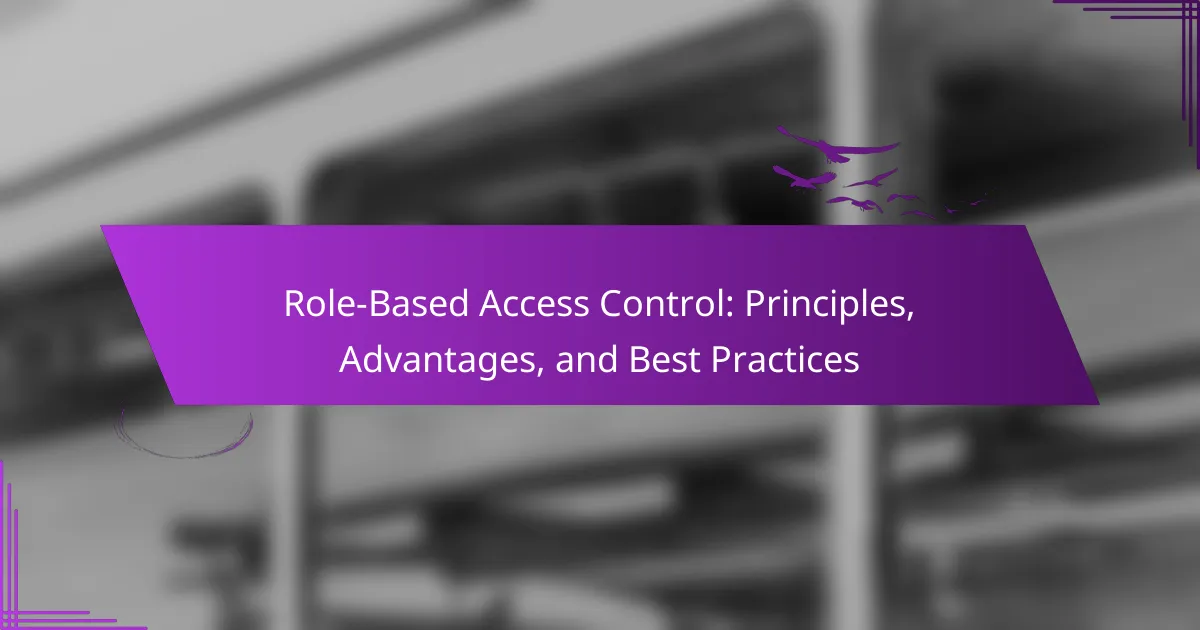
What is Role-Based Access Control?
Role-Based Access Control (RBAC) is a security mechanism that restricts system access to authorized users based on their role within an organization. In RBAC, roles are defined according to job functions. Each role is assigned specific permissions to access resources. Users are then assigned to these roles, granting them the appropriate access rights. This approach simplifies management of user permissions. It enhances security by ensuring users only have access necessary for their tasks. According to a study by Sandhu et al. (1996), RBAC can reduce the risk of unauthorized access significantly. The implementation of RBAC is widely recognized for improving compliance with security policies.
How does Role-Based Access Control function?
Role-Based Access Control (RBAC) functions by assigning permissions to roles rather than individual users. Users are assigned to specific roles based on their job responsibilities. Each role has defined access rights to resources and data. This structure simplifies management by grouping users with similar access needs.
RBAC ensures that users can only access information necessary for their role. This minimizes the risk of unauthorized access to sensitive data. The principle of least privilege is applied, granting users the minimum access required.
RBAC is widely implemented in various systems, including enterprise applications and databases. Its effectiveness is supported by studies showing reduced security breaches when using RBAC. This model streamlines administrative processes and enhances security compliance.
What are the key components of Role-Based Access Control?
The key components of Role-Based Access Control (RBAC) are roles, permissions, and users. Roles are defined sets of permissions assigned to users. Permissions specify access rights to resources within a system. Users are individuals or entities that are assigned to roles. This structure allows for efficient management of access rights. RBAC simplifies administration by grouping permissions into roles. It enhances security by enforcing the principle of least privilege. According to NIST, RBAC reduces the risk of unauthorized access by aligning user permissions with job functions.
How do roles and permissions interact in Role-Based Access Control?
Roles and permissions interact in Role-Based Access Control (RBAC) by assigning specific permissions to defined roles. Each role represents a set of responsibilities within an organization. Users are then assigned to these roles, inheriting the associated permissions. This structure simplifies management by centralizing permission assignments. For example, a role like “Admin” may have permissions to create, read, update, and delete records. In contrast, a “Viewer” role may only have read permissions. This separation ensures that users only have access necessary for their job functions. RBAC enhances security by minimizing excessive permissions. Studies, such as those by Sandhu et al. (1996), demonstrate that RBAC effectively reduces the risk of unauthorized access.
Why is Role-Based Access Control important?
Role-Based Access Control (RBAC) is important because it enhances security and efficiency in managing user permissions. RBAC restricts system access to authorized users based on their roles. This minimizes the risk of unauthorized access to sensitive information. According to a study by NIST, implementing RBAC can reduce the potential for data breaches by ensuring users have only the access necessary for their job functions. Additionally, RBAC simplifies user management by allowing administrators to assign roles rather than individual permissions. This streamlines the onboarding process and reduces administrative overhead. Overall, RBAC is crucial for maintaining data integrity and compliance with regulatory standards.
What security challenges does Role-Based Access Control address?
Role-Based Access Control (RBAC) addresses several security challenges. It mitigates the risk of unauthorized access to sensitive information. RBAC enforces the principle of least privilege, ensuring users have only the access necessary for their roles. This reduces the attack surface by limiting access rights. RBAC also simplifies user management by grouping permissions into roles. This makes it easier to audit access rights and compliance. Furthermore, RBAC helps in managing user roles consistently across the organization. By doing so, it minimizes the potential for human error in access control. Overall, RBAC enhances security by providing structured access management.
How does Role-Based Access Control enhance compliance?
Role-Based Access Control (RBAC) enhances compliance by ensuring that only authorized individuals access sensitive information. This minimizes the risk of data breaches and unauthorized access. RBAC aligns access permissions with regulatory requirements. It enables organizations to enforce policies consistently across user roles. By limiting access based on roles, RBAC simplifies audit processes. Auditors can easily verify who has access to what information. This traceability supports compliance with regulations like GDPR and HIPAA. Implementing RBAC can lead to reduced penalties for non-compliance. Organizations that use RBAC demonstrate a commitment to security and regulatory adherence.

What are the advantages of Role-Based Access Control?
Role-Based Access Control (RBAC) offers several advantages for managing user permissions. It simplifies access management by assigning permissions based on user roles. This reduces the complexity of managing individual user permissions. RBAC enhances security by ensuring that users only have access to information necessary for their role. This minimizes the risk of unauthorized access to sensitive data.
Additionally, RBAC improves compliance with regulatory standards. Organizations can easily demonstrate that access controls are in place. It also streamlines onboarding and offboarding processes. New employees can quickly be assigned roles, and access can be promptly revoked when they leave. Overall, RBAC increases operational efficiency and reduces administrative overhead.
How does Role-Based Access Control improve operational efficiency?
Role-Based Access Control (RBAC) improves operational efficiency by streamlining user permissions based on roles. This approach minimizes the complexity of managing access rights. It allows organizations to assign permissions to roles rather than individuals. Consequently, onboarding new employees becomes faster and more efficient.
RBAC also reduces the risk of unauthorized access. By limiting permissions strictly to necessary roles, organizations enhance security. This increased security can lead to fewer data breaches, which saves time and resources.
Moreover, RBAC simplifies compliance with regulatory requirements. Organizations can easily demonstrate adherence to access control policies. This simplification reduces the administrative burden on IT departments. Overall, RBAC fosters a more efficient operational environment by aligning access controls with business functions.
What impact does Role-Based Access Control have on user management?
Role-Based Access Control (RBAC) significantly enhances user management by streamlining permissions and access levels. It allows administrators to assign roles based on job functions. Each role has specific permissions associated with it. This reduces the complexity of managing individual user permissions. RBAC promotes security by enforcing the principle of least privilege. Users receive only the access necessary to perform their tasks. According to a study by Sandhu et al. (1996), RBAC improves operational efficiency and compliance. It minimizes the risk of unauthorized access and data breaches. Overall, RBAC simplifies user management while enhancing security and compliance.
How does Role-Based Access Control reduce the risk of data breaches?
Role-Based Access Control (RBAC) reduces the risk of data breaches by limiting access to sensitive information based on user roles. Each user is assigned a role that dictates their permissions within a system. This minimizes the number of individuals who can access critical data. By enforcing the principle of least privilege, RBAC ensures users only have access necessary for their job functions. This reduces the attack surface for potential breaches. According to a study by the National Institute of Standards and Technology, implementing RBAC can significantly decrease unauthorized access incidents. Thus, RBAC effectively protects sensitive data by controlling user access.
Which industries benefit most from Role-Based Access Control?
Healthcare, finance, and government sectors benefit most from Role-Based Access Control (RBAC). These industries handle sensitive data and require strict access management. In healthcare, RBAC protects patient information and complies with regulations like HIPAA. In finance, it safeguards financial data and ensures compliance with regulations such as PCI DSS. Government agencies utilize RBAC to manage access to classified information and maintain security protocols. Each of these industries relies on RBAC to minimize security risks and enhance operational efficiency.
What specific use cases highlight the effectiveness of Role-Based Access Control?
Role-Based Access Control (RBAC) is effective in various specific use cases. One prominent use case is in healthcare systems. RBAC ensures that only authorized personnel can access patient records, enhancing patient privacy and compliance with regulations like HIPAA. Another use case is in enterprise resource planning systems. RBAC allows companies to restrict access to sensitive financial data based on employee roles, minimizing the risk of data breaches. Additionally, in cloud services, RBAC helps organizations manage user permissions effectively. It ensures that employees can only access resources necessary for their job functions, thus reducing the attack surface. Furthermore, in educational institutions, RBAC can control access to student information and grades based on roles such as teachers and administrators. Each of these use cases demonstrates how RBAC strengthens security and operational efficiency in different sectors.
How do different sectors implement Role-Based Access Control?
Different sectors implement Role-Based Access Control (RBAC) by defining roles based on job functions. In healthcare, access is granted to medical records based on roles like doctors or nurses. In finance, roles determine access to sensitive financial data and transaction capabilities. Government agencies use RBAC to restrict access to classified information, ensuring only authorized personnel can view specific data. In education, RBAC manages access to student records and learning management systems based on roles like administrators, teachers, and students. Each sector tailors RBAC policies to meet regulatory requirements and protect sensitive information. This structured approach enhances security and ensures compliance across various industries.

What are the best practices for implementing Role-Based Access Control?
The best practices for implementing Role-Based Access Control (RBAC) include defining clear roles and responsibilities. Organizations should analyze job functions to create distinct roles. Each role must have specific permissions based on the principle of least privilege. This principle restricts access to only what is necessary for performing job duties.
Regularly reviewing and updating roles is crucial. This ensures that access levels remain appropriate as job functions evolve. Implementing role hierarchies can simplify management. Hierarchies allow for inheritance of permissions from higher-level roles to lower-level ones.
Documentation of roles and permissions is essential for compliance and auditing. Organizations should maintain a clear record of who has access to what resources. Training employees on RBAC policies enhances understanding and compliance. This reduces the risk of unauthorized access.
Lastly, utilizing automated tools can streamline the RBAC implementation process. These tools help in managing roles and permissions efficiently. Following these best practices can significantly enhance security and operational efficiency in access control.
How can organizations design effective roles in Role-Based Access Control?
Organizations can design effective roles in Role-Based Access Control (RBAC) by following a systematic approach. First, they should identify and analyze business processes and data access needs. This analysis helps in understanding which roles are necessary for different functions. Next, organizations must define roles based on job functions, ensuring that each role has specific permissions aligned with responsibilities.
Additionally, organizations should implement the principle of least privilege. This principle ensures that users have only the access necessary to perform their job functions. Regularly reviewing and updating roles is also crucial. This process helps in adapting to changes in the organization and its security requirements.
Furthermore, organizations can utilize role hierarchies to simplify role management. This approach allows for inheritance of permissions, making it easier to manage access rights. Training and awareness programs for employees about RBAC policies can enhance compliance and security.
Evidence shows that organizations employing RBAC effectively reduce security risks and improve operational efficiency. A study by Sandhu et al. highlights that RBAC can lead to better access control management and reduced administrative overhead.
What factors should be considered when defining roles?
Key factors to consider when defining roles in Role-Based Access Control (RBAC) include job responsibilities, access requirements, and the principle of least privilege. Job responsibilities determine what tasks users need to perform. Access requirements specify the data and resources necessary for those tasks. The principle of least privilege ensures users only have access to what is essential for their role. Additionally, organizational policies and compliance requirements must be considered to align roles with regulatory standards. Regular reviews of roles are essential to adapt to changes in the organization and technology. These factors collectively ensure that roles are well-defined, secure, and effective in managing access control.
How can organizations ensure role clarity and minimize overlap?
Organizations can ensure role clarity and minimize overlap by clearly defining roles and responsibilities. This involves creating detailed job descriptions for each position. Each job description should outline specific duties and expectations. Regular training sessions can reinforce these definitions among team members. Implementing a structured communication system helps address any ambiguities. Regularly reviewing and updating roles based on organizational changes is essential. A study by the Society for Human Resource Management found that clear role definitions improve team performance by 25%. This evidence supports the effectiveness of clear role delineation in reducing overlap.
What common pitfalls should be avoided in Role-Based Access Control?
Common pitfalls in Role-Based Access Control (RBAC) include overly broad role definitions. This can lead to excessive permissions for users. Another pitfall is neglecting regular reviews of roles and permissions. Without periodic audits, outdated access can remain in place. Additionally, failing to enforce the principle of least privilege can expose systems to unnecessary risks. Role explosion occurs when too many specific roles are created. This complicates management and increases the likelihood of errors. Lastly, not providing adequate training for users can result in misconfigurations. These pitfalls can undermine the effectiveness of RBAC systems.
What are the risks of poorly defined roles?
Poorly defined roles can lead to significant risks in organizations. These risks include confusion among team members about responsibilities. This confusion can result in overlapping duties and tasks being neglected. Additionally, unclear roles can hinder effective communication. Team members may not know who to approach for specific issues. This can lead to delays in decision-making and project execution. Furthermore, poorly defined roles can create security vulnerabilities. In systems with role-based access control, unclear roles may allow unauthorized access to sensitive information. According to a study by the Ponemon Institute, 62% of data breaches are linked to insufficient role definition. This highlights the critical importance of clearly defined roles in mitigating risks.
How can organizations maintain and review access controls effectively?
Organizations can maintain and review access controls effectively by implementing regular audits and updates. Regular audits help identify any discrepancies in access permissions. Organizations should establish a schedule for these audits, such as quarterly or bi-annually. Updates to access controls should occur whenever there are changes in personnel or job roles. This ensures that permissions align with current responsibilities. Additionally, organizations should utilize automated tools to track access and generate reports. Automated systems improve accuracy and reduce human error. Training staff on access control policies is also essential. Well-informed employees are less likely to misuse access privileges. These practices collectively enhance the integrity of access control systems.
What practical steps can organizations take to implement Role-Based Access Control successfully?
Organizations can implement Role-Based Access Control (RBAC) successfully by following a series of practical steps. First, they should define roles based on job functions and responsibilities. This ensures that access is aligned with users’ needs. Next, they must identify and categorize resources that require protection. Clear classification helps in determining which roles need access to specific resources.
After defining roles and resources, organizations should establish permissions associated with each role. This step ensures that users only have access to the information necessary for their tasks. Once roles and permissions are set, they should conduct a thorough user assignment process. This involves mapping users to their respective roles based on their job functions.
Regularly reviewing and updating roles and permissions is crucial for maintaining security. This practice addresses changes in job functions or organizational structure. Additionally, organizations should implement a monitoring system to track access and usage. This helps in detecting any unauthorized access attempts.
Training employees on RBAC policies and procedures is also essential. Educated users are less likely to make mistakes that could compromise security. Lastly, organizations should consider leveraging automated tools to streamline RBAC management. Automation can enhance efficiency and reduce the likelihood of human error.
Role-Based Access Control (RBAC) is a security framework that restricts system access based on user roles within an organization. This article outlines the principles of RBAC, its key components, and the importance of implementing such a system to enhance security and operational efficiency. It discusses how roles and permissions interact, addresses security challenges, and highlights best practices for effective RBAC implementation. Additionally, the article explores the advantages of RBAC across various industries and provides practical steps for organizations to maintain and review access controls effectively.
